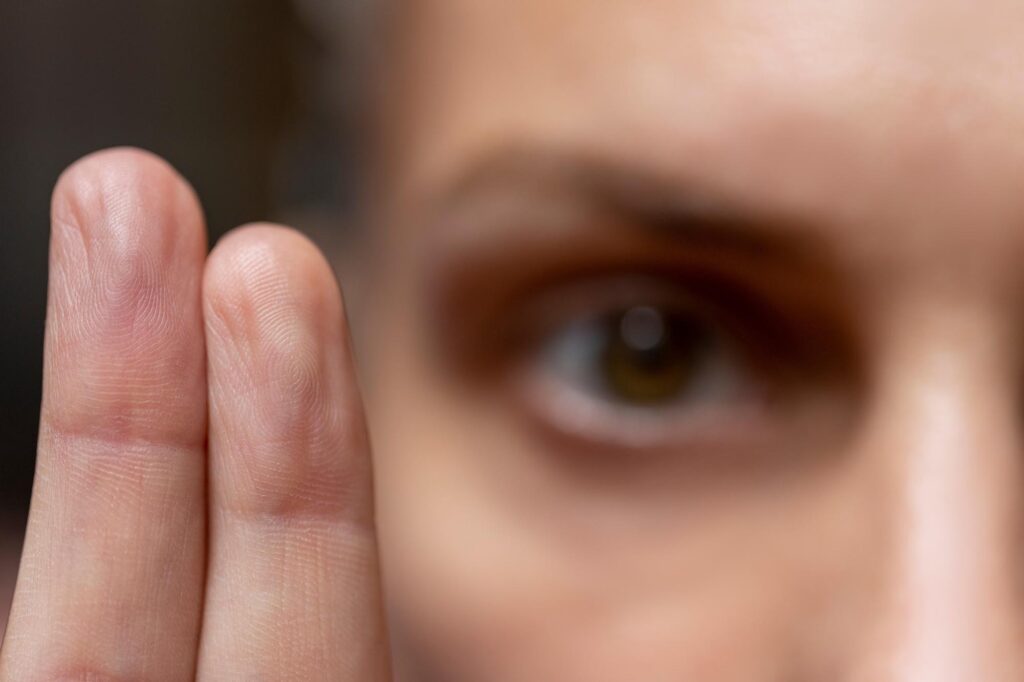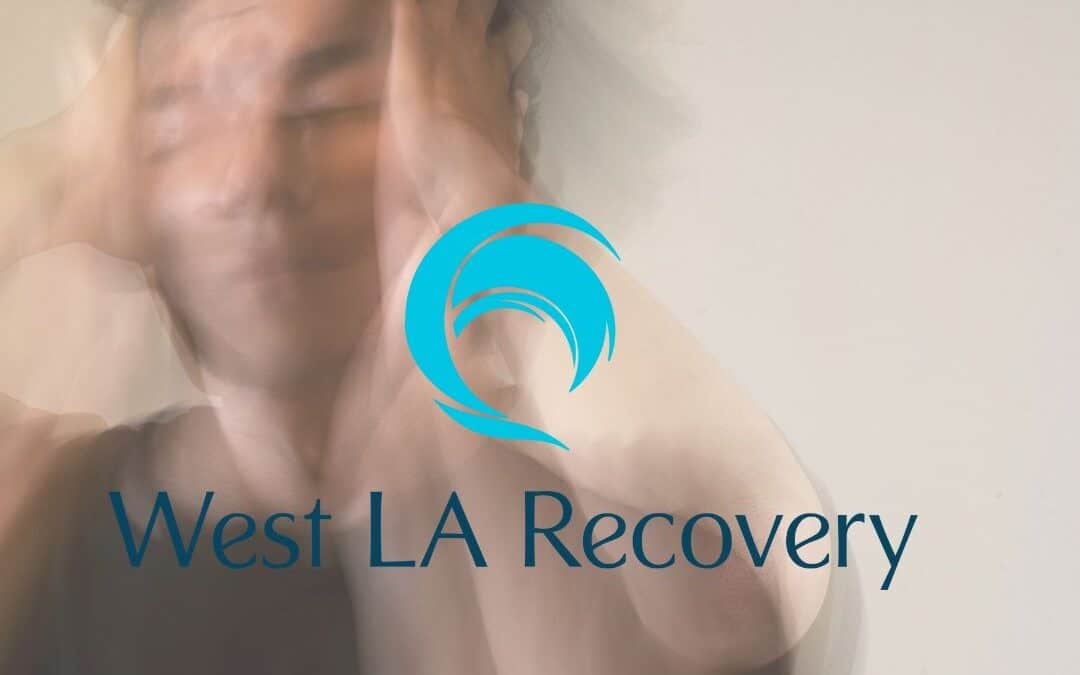1. Physical Signs of Hidden Opioid Addiction

Constricted Pupils
Constricted pupils serve as one of the most reliable opioid addiction physical signs you can observe. When someone uses opioids, their pupils become noticeably smaller than normal, appearing almost pinpoint-like even in dim lighting conditions. This occurs because opioids affect the nervous system’s control over pupil dilation.
Weight Loss and Deteriorating Personal Hygiene
Weight loss and deteriorating personal hygiene often accompany hidden opioid use. You might notice your loved one’s clothes fitting loosely, their hair appearing unkempt, or their dental health declining. These changes happen gradually as the person prioritizes drug use over self-care routines.
Sleep Disturbances
Sleep disturbances present another critical warning sign. Your loved one may experience:
- Excessive daytime sleepiness or “nodding off” at inappropriate times
- Severe insomnia during withdrawal periods
- Irregular sleep schedules that disrupt daily functioning
Flu-like Symptoms
Flu-like symptoms frequently mask opioid withdrawal, making detection challenging. These symptoms include persistent muscle aches, unexplained nausea, diarrhea, and general malaise that seems to come and go without clear medical cause.
Respiratory Changes
Respiratory changes represent the most serious physical indicator. Slow, shallow, or irregular breathing patterns signal dangerous opioid intoxication levels. This symptom requires immediate medical attention, as respiratory depression can be life-threatening.
Recognizing these signs of opioid addiction, such as those linked to the use of medications like Percocet, early allows you to intervene before the situation becomes more severe. Understanding the link between Percocet and opioid addiction, for instance, is crucial in identifying potential signs and seeking help promptly.
2. Behavioral Changes Indicating Concealed Opioid Use
Behavioral signs of opioid addiction often appear before physical symptoms become noticeable, making them crucial indicators for family members to recognize. You might notice your loved one exhibiting dramatic personality shifts that seem uncharacteristic of their usual demeanor. Someone who was once outgoing and cheerful may become withdrawn, irritable, or defensive when questioned about their activities or whereabouts.
Social Withdrawal
Social withdrawal is one of the most telling signs of hidden opioid use. Your family member may begin declining invitations to gatherings they previously enjoyed, making excuses to avoid spending time with friends or relatives. This isolation often stems from shame, fear of discovery, or the need to prioritize drug use over relationships.
Secretive Behavior Around Medications
Secretive behavior around medications becomes increasingly common as addiction develops. You may observe your loved one:
- Hiding pill bottles or keeping medications in unusual locations
- Being evasive when asked about their prescription refills
- Possessing opioids without a clear medical explanation
- Frequently checking medicine cabinets or searching through family members’ medications
Compulsive Patterns of Opioid Use
The compulsive pattern of taking opioids “just in case” reveals the psychological grip of addiction. Your loved one might carry pills everywhere, take medication before anticipated pain, or consume opioids prophylactically despite having no current medical need. This behavior demonstrates how addiction transforms medication from a medical tool into a psychological crutch that dominates decision-making processes.
3. Psychological Signs of Opioid Addiction
Addiction can often be detected through specific psychological signs that indicate opioid dependency, even before physical symptoms become noticeable. Here are some key indicators to look out for:
Intense Cravings
One of the most prominent signs of opioid addiction is the presence of overwhelming cravings. Your loved one may experience powerful urges to seek out and use opioids, which can consume their thoughts and influence their daily decisions.
- They may constantly think about their next dose or plan their entire day around obtaining or using opioids.
- You might notice them becoming visibly distressed or anxious when they can’t access their substance of choice.
Mood Swings
Opioid addiction can also lead to significant shifts in mood and emotional stability. The person you once knew as calm and predictable may now exhibit:
- Sudden irritability over minor issues
- Extreme highs followed by deep lows in emotions
- Unpredictable reactions during family interactions
- Defensive or hostile responses to innocent questions
These mood swings might resemble symptoms associated with Borderline Personality Disorder, making it essential to differentiate between the two.
Increased Anxiety
As opioid dependence worsens, anxiety levels often rise as well. Keep an eye out for signs such as:
- Restlessness or difficulty sitting still
- Excessive worry about everyday situations or events
- Panic attacks occurring when separated from their medication supply
This heightened anxiety is frequently rooted in fears related to withdrawal symptoms or running out of opioids.
The psychological impact of opioid addiction creates a cycle where managing emotions becomes nearly impossible without the drug. This leaves your loved one trapped in patterns of compulsive use, even though they genuinely want to quit.
It’s worth noting that similar psychological signs can also be observed in other forms of addiction, such as methamphetamine or even sex addiction, where intense cravings, mood swings, and increased anxiety levels are also prevalent.
4. Other Warning Signs of Hidden Opioid Addiction in Loved Ones
Prescription Misuse: A Red Flag for Opioid Addiction
Prescription misuse often reveals itself through medication management patterns that don’t align with prescribed usage. You might notice your loved one consistently running out of their prescription medication days or weeks before their next refill is due. They may frequently claim to have “lost” pills or provide elaborate explanations about spilled bottles or stolen medications. These scenarios, especially when they occur repeatedly, serve as significant red flags for opioid addiction detection.
Risky Behaviors: Escalating Dependence and Desperation
Risky behaviors escalate as dependence deepens and the need for opioids becomes more desperate. Your loved one might begin visiting multiple doctors to obtain additional prescriptions, a practice known as “doctor shopping.” They could start purchasing pills from friends, acquaintances, or even strangers. Some individuals resort to stealing medications from family members, friends, or even medical facilities where they work or visit.
The progression to illegal activities represents a critical warning sign of severe opioid addiction. You may discover unexplained cash withdrawals, missing valuables from your home, or learn that your loved one has been involved in prescription fraud or theft.
Subtle Cues: Observing Behavioral Changes
Subtle cues require careful observation beyond obvious physical symptoms. Watch for changes in their daily routines, unexplained absences, or defensive reactions when questioned about their activities. You might notice them researching pain management clinics online or showing unusual interest in others’ medical treatments. These behavioral shifts often precede more obvious signs of addiction.
5. How to Support a Loved One Suspected of Hiding Opioid Addiction
Supporting loved ones dealing with opioid addiction requires a delicate balance between concern and respect for their autonomy. It’s crucial to approach these conversations with genuine empathy rather than accusatory language that pushes them further into secrecy.
Creating Safe Dialogue
Start conversations during calm moments when your loved one isn’t under the influence. Use “I” statements to express your observations and concerns:
- “I’ve noticed you seem tired lately, and I’m worried about you”
- “I care about your wellbeing and want to understand what you’re going through”
- “I’m here to listen without judgment if you need someone to talk to”
Avoid confrontational phrases like “You’re addicted” or “You need to stop.” These intervention strategies often backfire, causing the person to become defensive and withdraw further.
Professional Resources and Recovery Month 2025
Recovery Month 2025 brings renewed focus on addiction awareness and available resources. This annual observance in September highlights the importance of treatment and recovery support services. You can use this momentum to introduce professional help options naturally.
Present treatment as healthcare rather than punishment. Research shows that family support significantly improves recovery outcomes when combined with professional intervention.
Our comprehensive programs address both individual needs and family dynamics, providing specialized support for those ready to begin their recovery journey. We understand the unique challenges families face when addiction affects their household. For more information on how we can assist you or your loved one, feel free to contact us.
In addition, if you’re seeking more information about the current opioid crisis, or if you want specific guidance on how to support a loved one in addiction treatment, we have a wealth of resources available.
Recognizing Signs in Specific Relationships: Child, Partner, Brother, Sister
How to tell if your partner is hiding an opioid addiction requires navigating complex trust issues. You might notice your partner becoming emotionally distant, making excuses for unexplained absences, or showing defensive behavior when questioned about their activities. Financial discrepancies, missing prescription bottles, or finding unfamiliar medications can signal partner hiding opioid addiction.
Is my brother hiding an opioid addiction? or is my sister hiding an opioid addiction? These questions become particularly challenging within family dynamics. Sibling opioid addiction signs often manifest as:
- Sudden changes in childhood personality traits
- Avoiding family gatherings or traditions
- Borrowing money frequently without clear explanations
- Dramatic shifts in friend groups or social circles
How to detect opioid addiction effectively requires family coordination. You can work together by:
- Sharing observations without accusations
- Documenting concerning behaviors objectively
- Maintaining open communication between family members
- Avoiding enabling behaviors while showing support
Each relationship presents unique challenges when detecting opioid addiction. Partners may feel betrayed by secrecy, while siblings might struggle with loyalty conflicts. Parents often blame themselves, and children may feel responsible for hiding a parent’s addiction.
The key lies in approaching each relationship with understanding while maintaining healthy boundaries. You don’t need to navigate these complex situations alone—professional guidance can help you address opioid addiction concerns effectively within your specific family dynamic.
FAQs (Frequently Asked Questions)
What are the physical signs of hidden opioid addiction to look out for?
Key physical signs of hidden opioid addiction include constricted (small) pupils, noticeable weight loss, neglect of personal hygiene, sleep disturbances such as excessive sleepiness or insomnia, flu-like symptoms like muscle pain, diarrhea, nausea, and slow or irregular breathing which is a serious warning sign.
How can behavioral changes indicate concealed opioid use?
Behavioral signs of concealed opioid use include secretive behavior around medications, social withdrawal and isolation from friends and family, shifts in attitude or personality signaling distress or concealment, and compulsive use patterns such as taking opioids ‘just in case’ even without medical need.
What psychological indicators suggest opioid dependence?
Psychological signs of opioid addiction often involve intense cravings for opioids that drive compulsive behavior despite negative consequences, mood swings including irritability, and heightened anxiety reflecting emotional symptoms of addiction.
What other warning signs might suggest a loved one is hiding an opioid addiction?
Additional warning signs include running out of prescription medication early or frequently losing pills, engaging in risky or illegal activities to obtain opioids, and subtle cues beyond obvious physical symptoms that may indicate hidden opioid misuse.
How can I support a loved one suspected of hiding an opioid addiction?
Supporting a loved one involves approaching conversations with empathy and concern rather than judgment, encouraging professional help by highlighting available resources especially during Recovery Month 2025, and considering specialized support services such as those offered by West LA Recovery tailored for families and individuals seeking help.
How can I recognize signs of hidden opioid addiction in specific relationships like partners or siblings?
Recognizing hidden opioid addiction in partners involves understanding challenges related to trust and communication. For siblings, look for changes in behavior within family dynamics. Family members can work together by observing unique signs specific to each relationship to effectively detect and address hidden opioid addictions.







